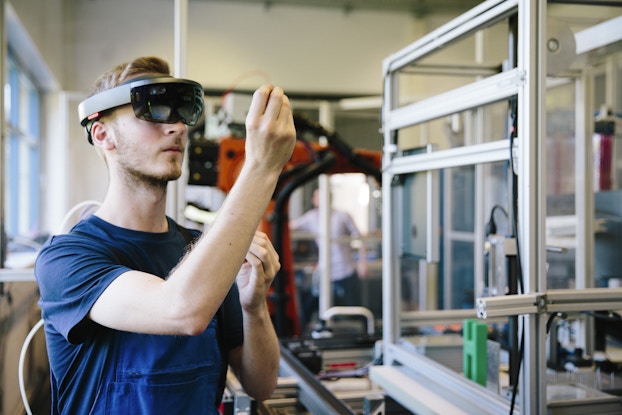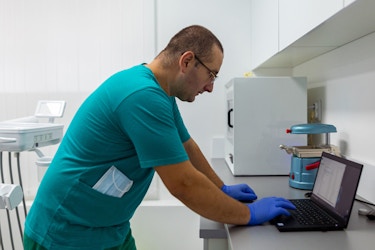
Even before the spread of COVID-19, the virtual/augmented reality market was expected to grow by nearly 79% in 2020. Small business owners should start thinking about how augmented reality (AR) and virtual reality (VR) can help you connect with employees and customers while still honoring social distancing. Beyond taking measures to stop the spread of COVID-19, how can AR and VR improve your business operations?
[Read more: Ready to Reopen: A Playbook for Your Small Business]
Augmented reality vs. virtual reality: What’s the difference?
Augmented reality (AR) “enhances the real world” by displaying images, text and information on device displays. Pokemon Go is a great example of augmented reality, where the user is seeing new information but is not fully immersed in a scene or alternate reality.
Virtual reality (VR) is completely immersive. A user puts on a VR headset and enters a new “world” where they are surrounded by virtual objects on a screen. Beyond entertainment purposes, VR can be used by surgeons to plan a complicated operation or to train soldiers for combat scenarios.
Augmented reality for small businesses
Augmented reality offers a way for customers to try your product before they buy it.
“Whereas customers would have previously had to physically go to a store to try a garment on or browse through jewelry, furniture or artwork, augmented reality allows customers to try on items and preview products virtually,” wrote SmallBizTrends.
Retailers that offer AR can access customers from all over the world, cut down on the number of returned items and improve customer satisfaction scores. Likewise, AR offers a way to provide great customer service: When used in-store, shoppers can scan products on a shelf and receive instant information related to the product. The novelty of AR still delights many customers and can improve your brand reputation.
AR is a great tool for training your employees and working efficiently. For instance, AR can overlay instructions as your team member works on a complicated technical project.
“In one test case, smart glasses made by Skylight aided a technician in wiring a wind turbine,” wrote Inc. Magazine. “Since he didn't have to look back and forth from the paper manual to the machine, he was able to complete the job 34% faster, although he had never used the smart glasses before.”
I think that VR will be a great way to reduce the amount of travel that’s required for business.
Annie Eaton, CEO of Futurus
Virtual reality for small businesses
As Annie Eaton, CEO of the technology company Futurus reported, VR is making virtual meetings more meaningful. “[Video] still is not quite as personal a connection as being in a room with someone in virtual reality, where you have 3D space. You can walk up to people and actually have separate conversations with members of the meeting depending on where you’re standing in the room, just like you would in real life,” she said. “I think that VR will be a great way to reduce the amount of travel that’s required for business.”
[Watch: Workshop Wednesday: Building New Workplaces for the Post-Pandemic World]
VR is also a great option for improving your product development. You could design a new product or test out a store layout in VR, asking customers for feedback before fine-tuning and replicating the design in the real world.
Like AR, virtual reality provides a new way for businesses to reach customers who aren’t in the immediate area. Host an event that anyone in the world can experience, set up a virtual fitting room or set up a virtual dining room for guests who order delivery to have dinner with their friends – all while honoring social distancing.
Best AR and VR tools
Right now, Facebook is offering its new Spark AR online tool for free. Spark AR offers a user-friendly way to create augmented reality content, with no coding experience required. Shopify also has an “AR Quick Look” tool that Shopify merchants can use to create 3D models of their products. Snapchat and Instagram also have augmented reality features that can encourage customer engagement and boost your marketing efforts.
Virtual reality requires more hardware than augmented reality. Eaton says the team at Futurus favors the Oculus Quest headset as an affordable option. These headsets start at $399. Samsung and HTC also make VR headsets. If buying one for each of your staff members feels extravagant, Eaton said there are aftermarket faceplate replacements specifically designed for sharing headsets without spreading germs from a company called VR Recover.
“They are vinyl and they’re used specifically for sanitation,” Eaton said. “We’re ensuring that if a device is passed between team members there’s always a way to wipe it down and make sure it’s completely clean.”
CO— aims to bring you inspiration from leading respected experts. However, before making any business decision, you should consult a professional who can advise you based on your individual situation.
Want to read more? Be sure to follow us on LinkedIn!
CO—is committed to helping you start, run and grow your small business. Learn more about the benefits of small business membership in the U.S. Chamber of Commerce, here.










